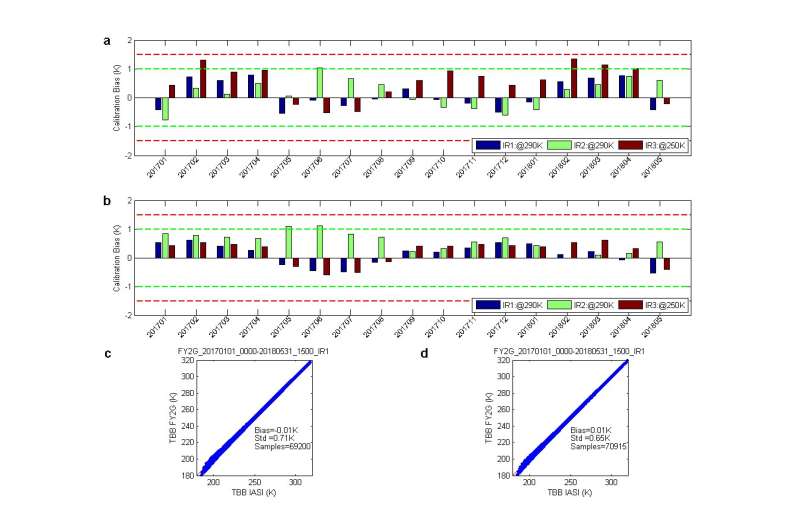Source-independent radiometric calibration (SIRC) for high-accuracy infrared remote sensing

Radiometric calibration (RC) guarantees measurements from infrared photonic sensors with certain accuracy, where a traditional radiation source will introduce unexpected uncertainties for degradation. To overcome such a limitation, Scientist in China proposed an original source independent RC (SIRC) principle by modeling the incident background radiation to both photoconductive and photovoltaic HgCdTe detectors, respectively. SIRC will ensure a long-term stable service of Chinese geostationary meteorological satellites and benefit the future infrared micro-satellite constellation for climate applications.
To guarantee measurements from infrared (IR) photonic sensors with certain accuracy, radiometric calibration (RC) is implemented to determine the radiometric responsivity of sensor and usually be solved by comparing with some radiation source (i.e. blackbody), called source based RC (SBRC). SBRC method provides a reasonable calibration way, where the targeted sensor is measured as a black-box to obtain its whole output when viewing the incident radiation from a source. However, there are three main intrinsic limitations in design, manufacture and application aspects for SBRC respectively. Firstly, since some non-ideal characteristics of a source (i.e. the emissivity of an available blackbody is absolutely less than unit) exist in nature, the additional uncertainty from such a source to the ultimate calibration results is inevitable. Secondly, it is hardly to be guaranteed that a well-qualified blackbody together with some relevant assembly are equipped for all IR sensors, particularly for those onboard the popular micro-satellite platforms. Finally, diverse sources will bring extra difficulties to unify the costs of traceability for different sensors, which is inacceptable for the current climate and climate change researches.
In a new paper published in Light: Science & Applications, a team of scientists, led by Professor Qiang Guo from National Satellite Meteorological Center, China Meteorological Administration, China, and co-workers from Shanghai Institute of Technical Physics, Chinese Academy of Sciences have proposed an original source independent RC (SIRC) principle based on modeling instead of comparing for SBRC, where the incident background radiation to detector, as a dominated factor influencing the responsivity characteristics of a photonic sensor, is modeled to implement RC for both two fundamental types (photoconductive and photovoltaic) of HgCdTe photonic detectors. The SIRC merely requires the temperature information of main components of a sensor other than some complex source and its assembly, and provides a traceable way at lower uncertainty costs relative to the traditional SBRC.

In essence, the characteristics of the sensor's calibrated response are independent of such a known and controlled source (e.g. blackbody for an IR sensor), which implies that we may obtain them in other ways, e.g. modeling with the dominant impact factors, instead of the traditional one by using measurement with a source. These scientists summarize the operational principle of SIRC:
"We propose the SIRC principle which establishes a new methodology to calibrate an infrared photonic senor by modeling the relationship between the incident background radiation and its responsivity for the available IR photonic detectors, particularly for space utilization. The main defects and limitations of SBRC are completely overcome in SIRC, e.g. without additional uncertainty from source, without a complex source or its assembly to be equipped, and easy to be traceable with some measured temperature information to provide more reliable measurements from a sensor."
"The proposed SIRC principle is expected to set up a whole new solution for both design and development of a spaceborne IR photonic sensor as well as its corresponding radiometric calibration processing on ground, and particularly benefit the IR measurement accuracy of micro-satellite constellation in a more applicable way."
"The SIRC is being implemented in Fengyun-2 satellites (FY-2G and FY-2F) since 2019, which ensures a long-term stable service of Chinese geostationary meteorological satellites for the global observation system under the framework of World Meteorological Organization. Moreover, a 20-year-period traceable Fengyun-2 dataset to be re-calibrated with SIRC will benefit the further climate applications."
More information: Qiang Guo et al, High-accuracy source-independent radiometric calibration with low complexity for infrared photonic sensors, Light: Science & Applications (2021). DOI: 10.1038/s41377-021-00597-4
Journal information: Light: Science & Applications
Provided by Chinese Academy of Sciences





















